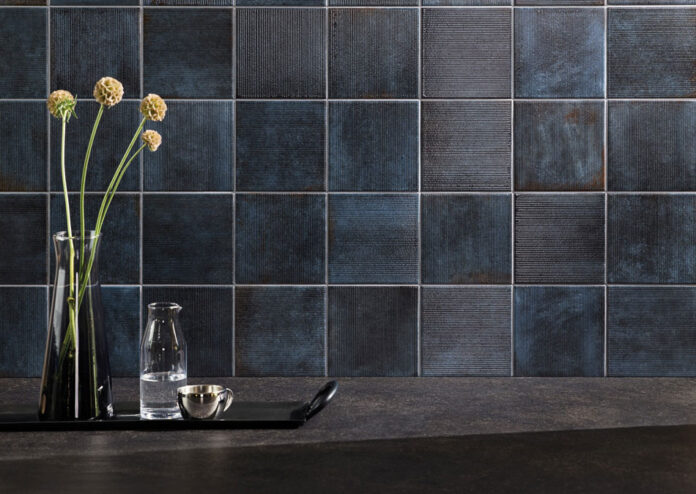Japandi bathroom design blends Japanese restraint with Scandinavian design to create a calm, uncluttered space. Bathrooms suit this approach well because they hold each day’s first and last rituals.
A well-designed Japandi bathroom helps you slow down and move with ease. This guide shows how to achieve timeless simplicity with Japandi bathroom design in real homes shaped by Japanese aesthetics.
Anchor the Space with Purposeful Layout
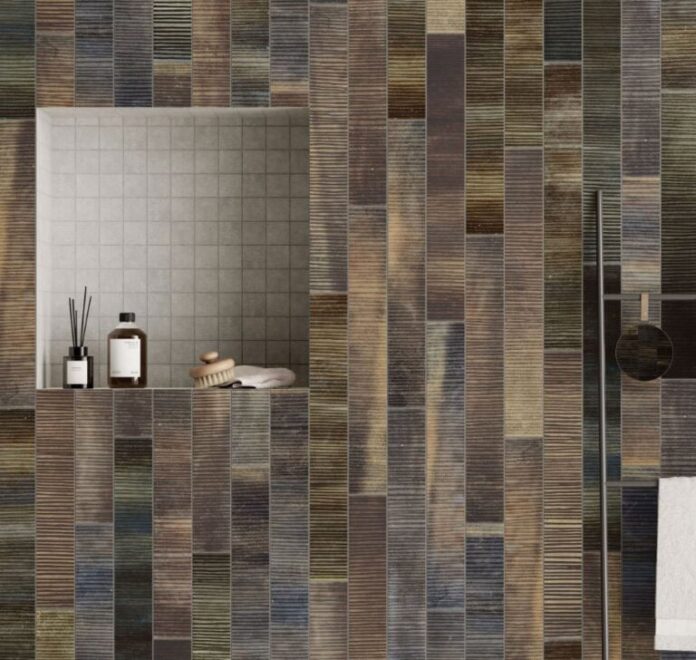
Flow matters more than decor. Japandi bathroom design works best when every zone has a clear purpose. Keep bathing, storage, and dressing areas defined but not boxed in. Open sightlines make the room feel larger and calmer. Straight countertop edges, aligned tiles, and continuous surfaces prevent visual noise.
Avoid rigid symmetry. A slightly off-center sink or asymmetrical vanity keeps the room from feeling sterile. Floating vanities and wall-mounted cabinets create lightness and make cleaning easier. Function should guide placement, but the final layout should feel effortless, not engineered.
Japandi bathroom tiles support layout clarity by creating smooth transitions between zones. Ceramic tile reflects Japandi values with its simplicity, durability, and refined texture. It opens up space and light with clean edges and timeless surfaces that guide movement.
Material Harmony
Japandi spaces rely on natural materials but don’t need to be predictable. Wood remains popular in contemporary design because it adds warmth and authenticity without overwhelming the space. Layer textures to keep the room inviting, such as smooth stone, soft cotton, and microcement walls with wood shelving.
Tones stay neutral, but neutral doesn’t mean flat. Warm clay, muted charcoal, and greige add depth without visual clutter. Consider materials like heat-treated wood for humidity resistance or paper composite counters for a soft touch. Small imperfections in materials add character and keep the space from feeling too polished. This balance reflects Scandinavian style, which favors warmth and simplicity without losing comfort.
Light as a Design Tool
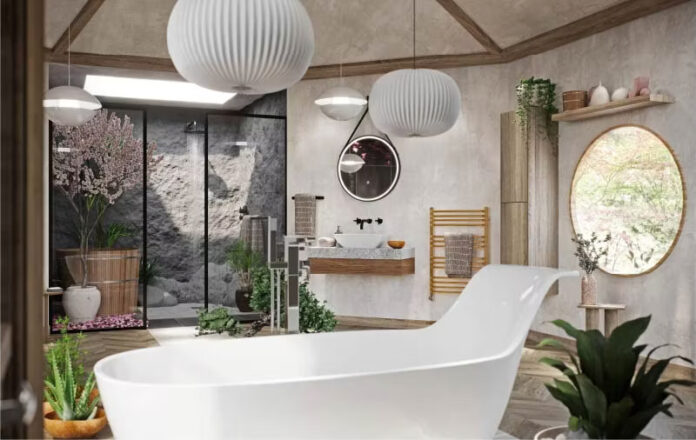
Lighting in a Japandi bathroom design sets the mood and shapes the room’s function. Instead of flooding the space with bright light, layer it with intention. Use soft ambient lighting for warmth and add hidden task lighting under mirrors or shelves. This keeps the room polished without harsh glare.
Frosted or ribbed glass softens light like shoji screens without copying them. Natural light should feel guided, not exposed. A narrow window or interior transom pulls daylight from another room while maintaining privacy.
Storage That Disappears
Clutter breaks simplicity, but storage shouldn’t look bulky. Built-in cabinets and recessed niches cut bulk and help essentials blend into the space. Sliding cabinet doors save space and avoid the constant stopping of swinging doors.
‘Visible with intention’ storage keeps the bathroom human. A single open shelf with folded towels or handcrafted jars adds warmth while the rest stays hidden. Vertical storage suits compact bathrooms when lines remain clean and finishes match. Storage in Japandi bathrooms follows the same efficiency in interior design for small urban homes.
Color Discipline with Warmth
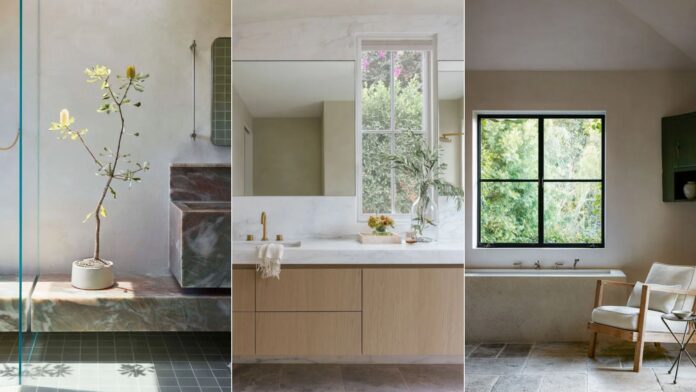
Japandi bathroom design favors neutral palettes, but the right neutrals matter. Warm undertones prevent the room from feeling cold. Soft whites, pale mushroom, or sandy beige make a gentle base. Darker flooring or charcoal grout adds a quiet contrast to ground the space.
For a fresh take, consider muted sage, dusty plum, or pale terracotta, which stay calm but feel more personal. Color temperature changes mood: warm whites feel inviting, while cool whites feel clinical. Consistency across surfaces keeps the palette calm and believable.
Sensory Calm Beyond the Visual
A truly soothing bathroom engages more than just the eyes. Sound, scent, and touch are key in Japandi bathroom design. Soft-close drawers and doors prevent sharp noises. Linen blinds or fabric mats help absorb echo. Choose faucets with a gentle water flow for a softer sound.
Scent should feel natural. Cedar, hinoki, or eucalyptus work well and pair with the Japandi style. Surfaces matter as much as looks. Smooth stone, cork, or treated wood feels pleasant under bare feet and reinforces the sense of ritual. This sensory focus draws inspiration from Zen philosophy, which values stillness and presence.
Quiet Fixtures and Hardware
Choose fixtures with simple lines and soft curves or squared edges. Avoid shiny chrome and use matte finishes like black, brushed nickel, or warm bronze to reduce glare. Wall-mounted faucets keep surfaces clear and make cleaning easier.
If space allows, a Japanese-inspired soaking tub adds comfort without excess decoration. Deep basin sinks with Scandinavian design influence add function while keeping the look simple.
Personalization Through Restraint
Japandi bathroom design leaves room for personality, but not in the form of scattered decor. Choose one handcrafted item or meaningful accessory, such as a ceramic tray or a handwoven basket. A teak stool beside the tub or a linen robe on a wooden hook adds quiet luxury.
Instead of filling the space, change up textures to signal individuality. Stone soap dishes, soft textiles, or curved mirrors add character without creating visual noise. The same restraint can extend to the living area, creating harmony throughout the home.
Maintenance Made Effortless
A beautiful bathroom should also be easy to care for. Seamless surfaces, minimal grout lines, and wall tiles that extend higher help protect walls and speed up cleaning. Floating furniture allows quick access to the floor.
Neutral palettes hide minor marks better than glossy white. Good design reduces upkeep, which makes simplicity more livable. Choosing natural materials wisely also improves hygiene and comfort without sacrificing beauty.
Conclusion
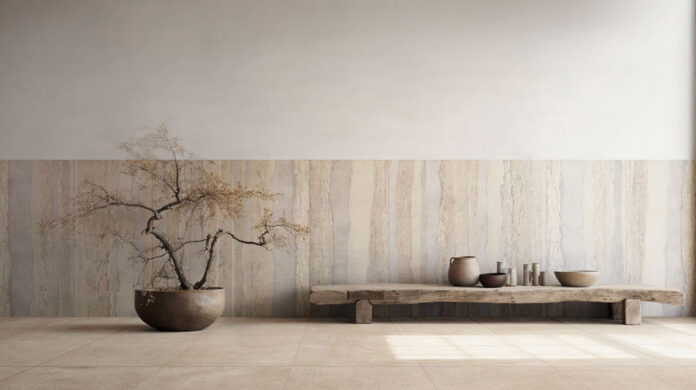
Japandi bathroom design shines when it supports daily rhythm. Layout, materials, light, and fixtures should work together to make each task smooth and calming. It isn’t about removing personality. It’s about eliminating distraction. A well-designed Japandi bathroom stays grounded, functional, and graceful as habits evolve with the enduring appeal of the Japandi style.

